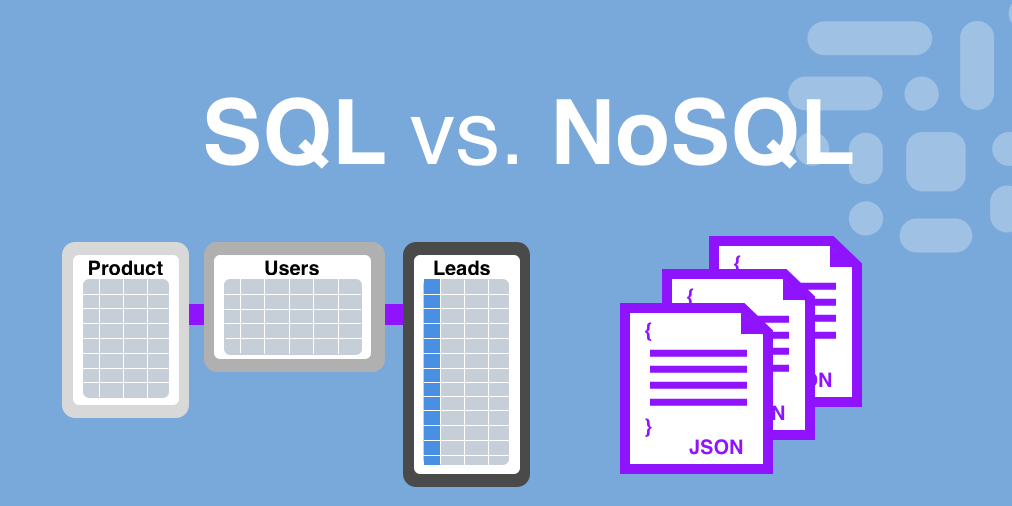SQL vs NoSQL
Data is at the heart of today's apps; modern businesses simply cannot function without it.In many ways, today's business is data-driven. Bussinesses would be unable to manage their finances, make transactions, or communicate with their consumers without data. To store and arrange this information, databases are constructed. The better the database's architecture and utility, the better positioned the company will be to complete for business.
One of the most important considerations when selecting a modern database is whether to use a relational (SQL) or non-relational (NoSQL) data structure. While both are excellent solutions, there are significant distinctions between them that customers should consider before making a choice. In this post, we'll look at the differences between them and how they assist developers.
What is a SQL database?
SQL stands for Structured Query Language, and it's a database programming language. This language enables you to work with data in tables and displays a query language for these tables and other associated objects (views, functions, procedures, etc.). Most databases, such as SQL Server, Oracle, PostgreSQL, MySQL, and MariaDB, use this language to handle data (with a few extensions and modifications).
You can use SQL to insert, delete, and update data. Database objects can also be created, deleted, or modified.
What is a NoSQL database?
Non-tabular databases (sometimes known as "not simply SQL") store data differently from relational tables. NoSQL databases are classified according to their data model. Document, key-value, wide-column, and graph are the most common types. They have adaptable schemas and can handle big amounts of data and high user loads with ease.
When individuals say "NoSQL database," they're usually referring to any database that isn't relational. Some people claim "NoSQL" means "not only SQL," while others say it means "non SQL." In any case, most people agree that NoSQL databases are databases that don't use relational tables to store data.
When should you use SQL vs. NoSQL?
When to use SQL
For relational data, SQL is the best database to employ, especially when the link between data sets is well-defined and easily accessible. It's also the greatest way to check for data integrity. SQL enables for high-level ad-hoc queries and, in most circumstances, SQL databases are vertically expandable if you need flexible data access (i.e., increase a single server workload by increasing RAM, CPU, SSD, etc).
Some SQL databases have specific characteristics that support NoSQL workloads (for example, native JavaScript Object Notation (JSON) data types). If you don't require the horizontal scalability of NoSQL data storage, these databases can handle a variety of non-relational applications. This allows them to work with both structured and unstructured data without the need for multiple data repositories.
Although NoSQL is easy, users must consider the data storage' consequences when developing apps. They must also think about write consistency, eventual consistency, and how sharding may affect data access and storage. These problems, on the other hand, do not apply to SQL databases, making them easier to develop applications for. Furthermore, their widespread use and versatility make even the most complex queries easier to understand.
When to use NoSQL
For vast amounts of data or constantly changing data sets, NoSQL is the best database to employ. When you have flexible data models or needs that don't fit into the relational model, it's also the ideal option. "Document databases" (e.g., CouchDB, MongoDB, Amazon DocumentDB) are a suitable choice if you're working with vast amounts of unstructured data. Redis is a perfect choice if you need quick access to a key-value store without strong integrity guarantees. Do you require a complex or flexible search across a large amount of data? Elasticsearch is the ideal solution.
Many NoSQL data stores emphasise horizontal scalability. Their built-in sharding and high availability requirements, unlike SQL, make horizontal scaling (or "scaling out") easier. Furthermore, because NoSQL databases such as Cassandra have no single points of failure, applications can easily react to individual member failures.
Conclusion
Both SQL and NoSQL database formats store data, although they do so in different ways. Outline the application to select a database model that is compatible with data structures such as schema, relation, scalability, and data size. Migrating from one to the other is expensive and time-consuming, thus the differences should be taken into account while designing software.
Connect to me on LinkdIn!







0 Comments